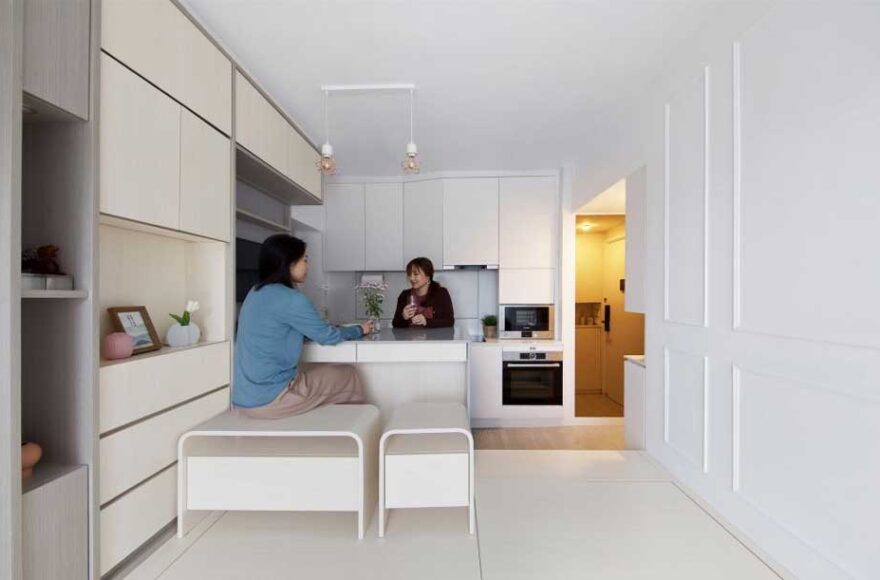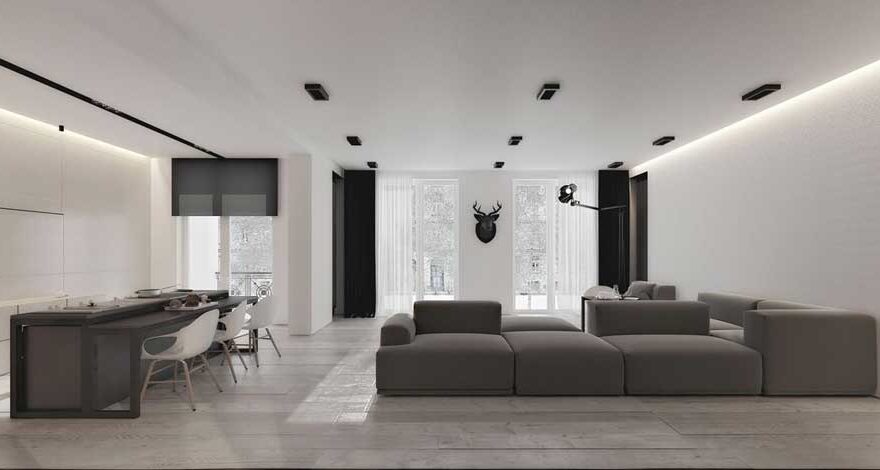Practical Guide to Selecting a Modern Leather Sectional for Contemporary Living Spaces


Selecting a modern leather sectional involves balancing comfort, durability, and visual appeal to suit a contemporary living space. Begin by assessing the room’s layout to determine the appropriate size and orientation. Sectionals are available in L-shaped, U-shaped, or modular configurations, each suited to different floor plans and seating needs.
Material quality is a key factor. Top-grain and full-grain leathers offer durability and rich texture, while semi-aniline and corrected-grain options provide stain resistance and easier care. Leather in neutral colors such as beige, charcoal, or taupe aligns well with contemporary aesthetics, notes Abacus Avenue Property Management.
Design features should reflect modern simplicity—clean lines, low profiles, and minimal ornamentation. Consider metal or wood legs, adjustable headrests, and integrated recliners for added functionality. Seat depth and cushion firmness also influence long-term comfort.
In summary, a well-chosen modern leather sectional enhances both form and function, making it a centerpiece that supports everyday living with refined elegance and practical convenience.
Key features that define a modern leather sectional
A modern leather sectional is defined by sleek design, thoughtful structure, and high-performance materials. These sofas are designed with functionality and style in mind, offering versatile seating arrangements for contemporary spaces.
One key feature is the clean silhouette. Straight lines, low profiles, and angular corners create a minimalist appearance that complements open floor plans and modern interiors. Modular components allow for flexible configurations, adapting to various room shapes and usage needs.
Leather quality also contributes significantly. Premium options such as top-grain or semi-aniline leather ensure longevity, comfort, and a refined texture. These surfaces are both attractive and resilient, often treated for easy maintenance.
Functional elements like integrated recliners, adjustable headrests, or built-in storage enhance practicality. Some models include USB ports or hidden compartments for added convenience.
Types of leather used in modern sectionals and their characteristics
Different types of leather are used in modern sectionals, each offering unique characteristics in texture, appearance, and maintenance. Understanding these options helps in choosing a material that suits both aesthetic preferences and lifestyle needs.
Top-grain leather is one of the highest quality choices. It is sanded slightly to remove imperfections and treated to create a smooth, uniform surface. It is durable, soft, and resistant to wear over time.
Full-grain leather is less processed, preserving the natural texture and markings of the hide. This type ages well, developing a rich patina, but it requires more care to maintain its condition.
Split leather, taken from the lower layers of the hide, is more affordable and often used in less visible areas. It has a firmer texture and may be coated for added durability.
Bonded leather is made from leather scraps and fibers bound with polyurethane. It mimics the look of real leather but lacks the strength and longevity of higher-grade options.
Common configurations: L-shape, U-shape, and modular options
Common sectional configurations offer versatility and function to suit different room sizes and seating needs. Among the most popular styles are L-shape, U-shape, and modular options, each providing distinct advantages for contemporary living spaces.
L-shape configurations are ideal for medium-sized rooms. They create clear boundaries and offer ample seating without overwhelming the space. Often placed in corners, they support open layouts and maximize wall space efficiently.
U-shape layouts suit larger rooms and encourage conversation by enclosing the seating area. They typically include three connected sections, allowing multiple people to sit comfortably while facing each other. This style works well for family gatherings or entertainment purposes.
Modular sectionals provide the most flexibility. Composed of individual units, they can be rearranged to fit evolving needs or room dimensions. These pieces often include armless chairs, chaise lounges, or ottomans that can be connected or separated with ease.
Each configuration supports modern lifestyles through adaptability and aesthetic coherence.
Frame and suspension materials influencing comfort and durability
Frame and suspension materials play a vital role in determining the comfort and long-term durability of any upholstered furniture. These components form the structural foundation, influencing stability, resilience, and daily functionality.
Frames are commonly constructed from hardwoods such as kiln-dried oak, maple, or beech, chosen for their strength and resistance to warping. Engineered wood or metal frames are also used in more contemporary designs, offering lighter weight and consistent performance. A well-constructed frame ensures lasting support and prevents structural fatigue over time.
Suspension systems directly affect seating comfort. Eight-way hand-tied springs are a traditional and premium method, offering balanced support and flexibility. Sinuous springs, made from heavy-duty steel, are widely used for their durability and responsiveness. Webbing suspension, often found in modern pieces, provides a firm yet adaptable base.
Together, these materials determine how furniture holds up to daily use while supporting posture and preserving the original shape and comfort of each piece.
Considerations for space planning and room layout integration
Effective space planning is essential for achieving both visual harmony and practical use within any interior. A well-organized room layout improves circulation, emphasizes focal points, and ensures every element serves a purpose without overwhelming the space.
Begin by evaluating room dimensions and architectural features such as windows, doors, and existing fixtures. This helps determine where to position major furnishings while maintaining balance and accessibility. Avoid obstructing natural light sources or walkways, as clear movement paths are vital for comfort and functionality.
In open-plan areas, defining zones with rugs, lighting, or sectional furniture can establish boundaries without using physical walls. Smart space planning ensures the environment remains efficient, adaptable, and pleasing—supporting both aesthetic goals and daily living needs.
Leather maintenance and cleaning practices for long-term care
Proper maintenance is key to preserving leather furniture and extending its lifespan. Routine care helps retain its natural beauty while protecting against wear, stains, and fading. Regular attention ensures that the material remains both functional and visually appealing.
Begin by dusting the surface weekly with a soft cloth to remove dirt and particles that could cause abrasion. For deeper cleaning, use a damp cloth with a mild, pH-balanced soap specifically formulated for leather. Avoid excessive moisture, as it can damage the leather’s finish and structure.
Keep leather away from direct sunlight, heating vents, and humid areas to avoid fading, warping, or mildew. With consistent care, this material maintains its sophisticated appearance and comfort, supporting long-term enjoyment and dependable performance.
Comparative cost analysis: Entry-level vs premium models
Conducting a comparative cost analysis between entry-level and premium models reveals important distinctions in price, quality, and long-term value. Entry-level options are typically more affordable, making them suitable for budget-conscious consumers or temporary use. These models often use less expensive materials, simplified construction, and minimal design features, which may affect durability and visual appeal over time.
In contrast, premium models command higher prices due to superior craftsmanship, long-lasting materials, and additional features. These may include high-grade leathers, hardwood frames, or advanced comfort technologies such as integrated recliners or modular flexibility. While the initial cost is greater, premium models often require less frequent replacement and offer enhanced comfort and aesthetics.
Comparative cost analysis helps determine which choice aligns best with specific needs and expectations. For those prioritizing longevity and design sophistication, a premium model may represent better long-term value. Entry-level models remain a practical alternative where budget or short-term use is the main concern.
Integration with modern interior design themes
Integrating furnishings into modern interior design themes involves aligning style, scale, and material to achieve a cohesive, functional space. Clean lines, neutral palettes, and minimalist aesthetics define modern interiors, and each furniture piece should contribute to this streamlined effect.
Choose items with geometric shapes and understated finishes to reflect contemporary sensibilities. Metal, glass, or light-toned wood materials complement open layouts and create an uncluttered appearance. Upholstery in leather or textured fabrics adds comfort while maintaining a modern profile.
Color coordination plays an important role. Use tonal layering and subtle contrasts rather than bold patterns. Decorative accents such as monochrome artwork, sculptural lighting, or low-profile accessories enhance visual interest without excess.
Functionality is equally important. Multi-use pieces and modular configurations allow flexibility and efficient space use. Thoughtful integration with modern interior design themes ensures the environment remains both aesthetically consistent and adaptable to evolving preferences, supporting a refined and purposeful lifestyle.
Factors to assess before purchase: Functionality, size, and usage needs
Before making a purchase, it is important to assess several key factors to ensure the item fits both lifestyle and design expectations. Understanding the intended functionality is the first step. Determine how the piece will be used on a daily basis—whether it needs storage, versatility, or specific ergonomic features—and verify that it meets those needs without unnecessary extras.
Next, consider the size of the item in relation to the available space. Proper measurements should be taken to allow comfortable movement and clearances around surrounding furniture. Oversized pieces may overpower the room, while undersized ones can feel disconnected or inadequate.
Lastly, reflect on your usage needs. Frequency of use, number of users, and room layout will influence material choice, construction quality, and design features. Prioritizing practical considerations alongside style helps avoid costly mistakes. A thoughtful approach ensures the chosen piece enhances both function and visual harmony in the space.


